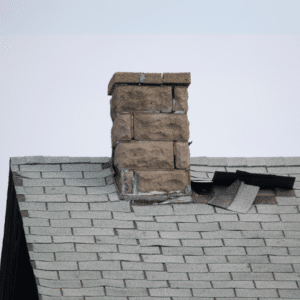Will shingles lifted by wind reseal themselves or require repair? This common concern arises after storms, leaving homeowners wondering if their roof will recover or need professional attention. Shingles lifted by wind can expose your home to leaks and long-term structural damage. This article provides expert insight to help you assess the situation and make the best decision for your home’s protection.
Shingles lifted by wind may sometimes reseal if the adhesive is intact and temperatures are warm enough to reactivate it. However, in many cases, they require repair due to compromised sealing strips that prevent proper adhesion, structural damage that weakens the shingle’s integrity, and increased risk of leaks and further wind damage.
- Understanding the Risks: What Happens When Wind Lifts Your Shingles
- Will Shingles Lifted by Wind Reseal Themselves or Require Repair
- When to Take Action: Signs Your Shingles Need Immediate Repair
- Repair vs. Replacement: What’s the Best Solution for Your Roof
- Preventative Measures: How to Protect Your Roof from Future Wind Damage
- Working with a Trusted Roofing Expert: Ensuring Quality Repairs
- Final Thoughts: Protect Your Roof Before It’s Too Late
Key Takeaways:
- Shingles lifted by wind may reseal, but it’s not guaranteed. Warm temperatures and intact adhesive are essential.
- Delayed repairs can lead to costly damage. Look for signs like curling, leaks, or missing granules.
- Regular inspections prevent major issues. Catching damage early saves time and money.
- Professional repairs ensure long-term durability. Experts use proper sealing techniques and materials.
- Preventative measures protect your roof. High-wind-rated shingles and routine maintenance enhance durability.
While some shingles lifted by wind may reseal, relying on this can lead to costly damage. Knowing what affects resealing and when to act is key to protecting your home. Keep reading to assess the damage and determine the best steps for shingles lifted by wind repair.
Understanding the Risks: What Happens When Wind Lifts Your Shingles
High winds are a leading cause of roofing damage, and shingles lifted by wind can create serious vulnerabilities. Notably, between 2018 and 2022, 2.8% of insured homes experienced wind and hail damage, underscoring the prevalence of such issues. When shingles no longer sit flush against the roof, they expose your home to moisture intrusion, mold growth, and structural deterioration. Wind damage weakens the adhesive seal that keeps shingles in place, making them more prone to future lifting.
If shingles are raised enough to expose the underlayment, water can seep beneath, leading to leaks and costly repairs. A single loose shingle can also compromise nearby shingles, increasing the risk of further damage. Colorado homeowners, especially in storm-prone areas, should regularly inspect their roofs for shingles lifted by wind to address issues early and prevent major repairs.
Will Shingles Lifted by Wind Reseal Themselves or Require Repair
If shingles lifted by wind have intact sealant and warm temperatures persist, some may reseal naturally over time. However, relying on this can be risky. Sealant activation requires prolonged exposure to temperatures of 70°F or higher, and even then, the sealing strip may be compromised. Once separated, it might not create a strong enough bond to withstand future storms. Additionally, underlying structural damage could exist, even if the shingles appear to have resealed. If shingles lifted by wind do not properly adhere within a few weeks, professional repairs are necessary to prevent further deterioration and costly damage.
When to Take Action: Signs Your Shingles Need Immediate Repair
Waiting for shingles lifted by wind to reseal naturally can lead to costly damage, making early action essential to prevent expensive repairs. In 2019, wind and hail damage made up 34.3% of property damage claims nationwide, highlighting the financial risks of delaying necessary roof repairs. Signs that your roof needs attention include shingles that remain lifted or curled, indicating a failure to reseal properly.
Water stains inside your home suggest moisture has seeped beneath the shingles, while granule loss makes them more vulnerable to further wind damage. Soft or sagging areas on the roof can also signal moisture damage to the decking. If you notice any of these warning signs, a professional inspection can determine whether repair or replacement is necessary to address shingles lifted by wind before more serious issues develop.
Repair vs. Replacement: What’s the Best Solution for Your Roof
Not all wind damage requires a full replacement. Knowing when to repair or replace shingles lifted by wind ensures you make a cost-effective decision. Roof repairs are ideal if only a few shingles are affected, there’s no major structural damage, and the adhesive seal can be reactivated. On average, roof repairs cost homeowners $1,067 but typically range from $379 to $1,755, making them a budget-friendly option.
However, a full replacement is necessary when a large section of shingles lifted by wind has detached, compromising the roof’s integrity. If repeated wind damage weakens the structure or the roof nears the end of its lifespan, ongoing repairs may not be cost-effective. A professional inspection can determine the best solution.
Preventative Measures: How to Protect Your Roof from Future Wind Damage
The best way to prevent shingles lifted by wind is through proactive roof maintenance. Installing high-wind-rated shingles enhances durability, as they are designed to withstand stronger gusts. Proper installation is also essential since poorly secured shingles are more likely to lift. Regular inspections help identify minor issues before they become costly repairs. Reinforcing roof edges—one of the most vulnerable areas—adds extra protection against wind damage.
Taking these preventative measures extends your roof’s lifespan and reduces the risk of storm-related damage. Regular maintenance not only protects against leaks and structural issues but also helps maintain your home’s energy efficiency. Being proactive with shingles lifted by wind minimizes repair costs and prevents more serious long-term damage.
Working with a Trusted Roofing Expert: Ensuring Quality Repairs
While DIY repairs may seem like a way to save money, improperly fixing shingles lifted by wind can lead to more expensive problems over time. A professional roofer can assess whether resealing is possible or if a roof replacement is needed. They use industry-grade adhesives and materials, ensuring long-term durability and protection against future wind damage. Many roofing companies also offer warranties on repairs and replacements, giving homeowners added peace of mind. Choosing an experienced contractor ensures the job is done right the first time, preventing further damage and unexpected costs down the road.
When choosing a contractor, look for licensed and insured professionals with experience handling wind damage repairs in Colorado’s unique climate—like Just Roofs and Gutters, a trusted local expert in roof repair and replacement.
Final Thoughts: Protect Your Roof Before It’s Too Late
Shingles lifted by wind can compromise your home’s protection, and while some may reseal naturally, many require professional repairs to prevent long-term damage. Ignoring lifted shingles can lead to leaks, structural issues, and costly replacements down the line. Regular inspections, proper maintenance, and knowing when to take action are key to keeping your roof in top shape, especially in Colorado’s unpredictable weather.
Don’t wait until minor damage becomes a major problem. Stay ahead of potential roofing issues with a quick and hassle-free estimate. Get your online roof estimate in seconds with Just Roofs and Gutters—an easy way to assess your roof’s condition and plan for any necessary repairs or replacements.
How Can I Spot Shingles Lifted by Wind Without Climbing My Roof?
Shingles lifted by wind may look misaligned or curled at the edges. Check for missing granules in gutters or debris in the yard. Inside, watch for water stains on ceilings or walls. If unsure, a professional inspection can confirm damage.
Can Wind Damage a Roof Without Removing Shingles?
Yes, shingles lifted by wind may stay in place but still weaken. Even slight lifting can break the adhesive seal, making shingles vulnerable to future storms. Left unchecked, this can lead to leaks, granule loss, and long-term roof deterioration.
Does Homeowners Insurance Cover Shingles Lifted by Wind?
Many policies cover shingles lifted by wind, but approval depends on maintenance and roof condition. If lifted shingles cause leaks or structural issues, repairs may be covered. Always document damage and check your policy before filing a claim.





